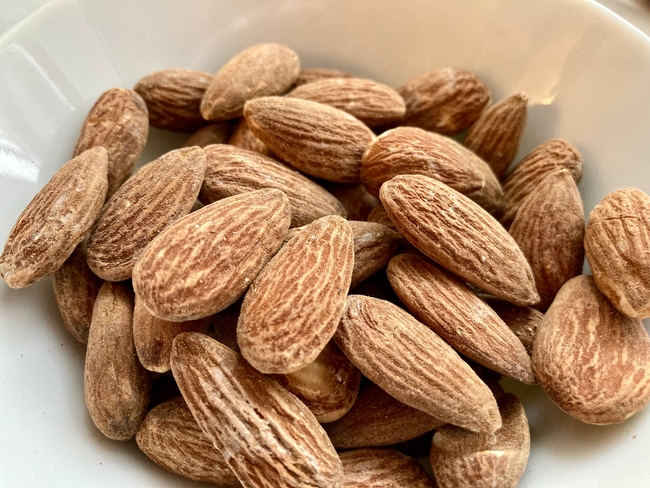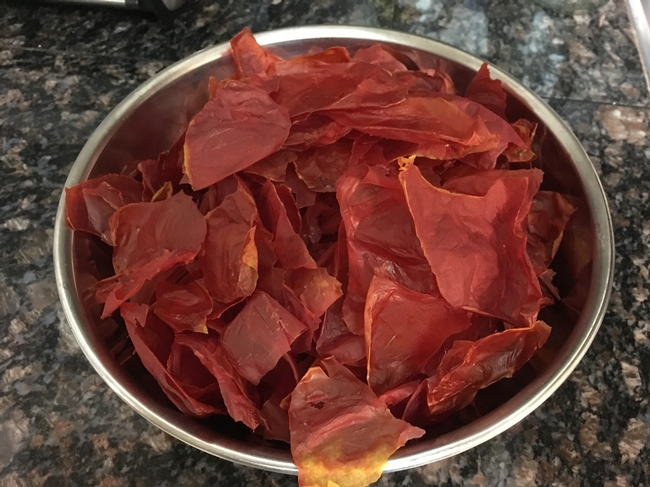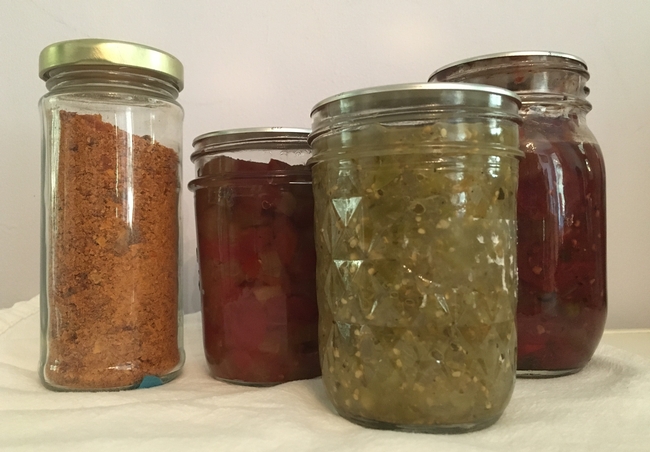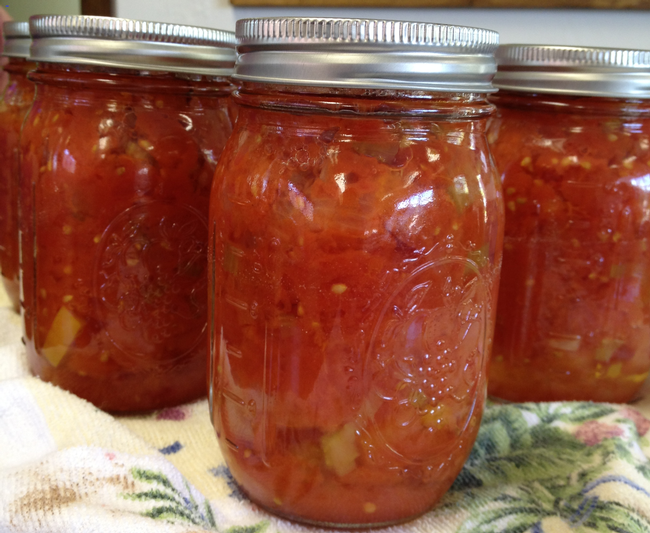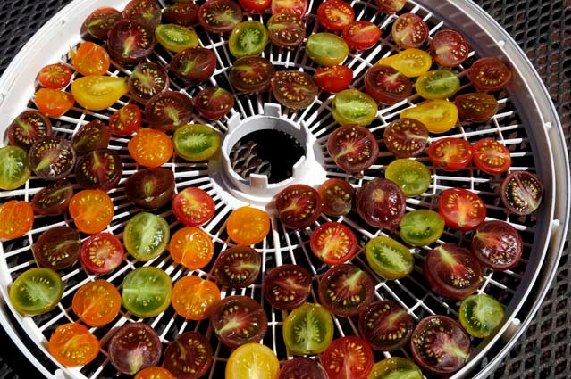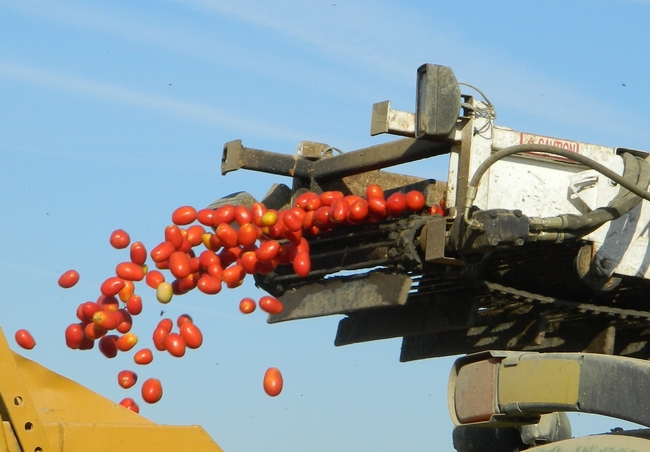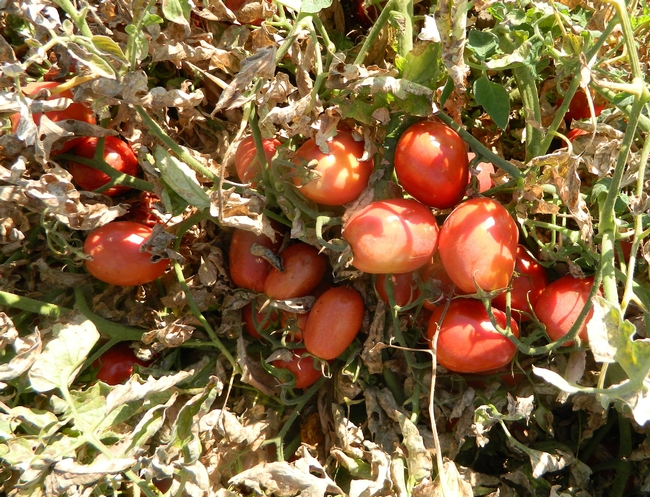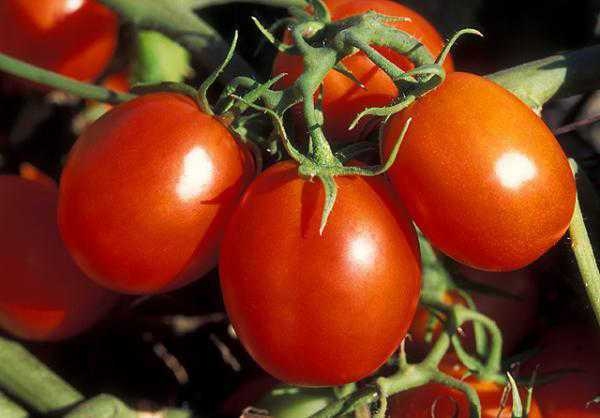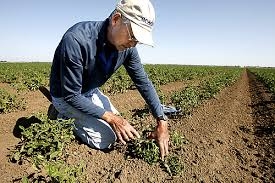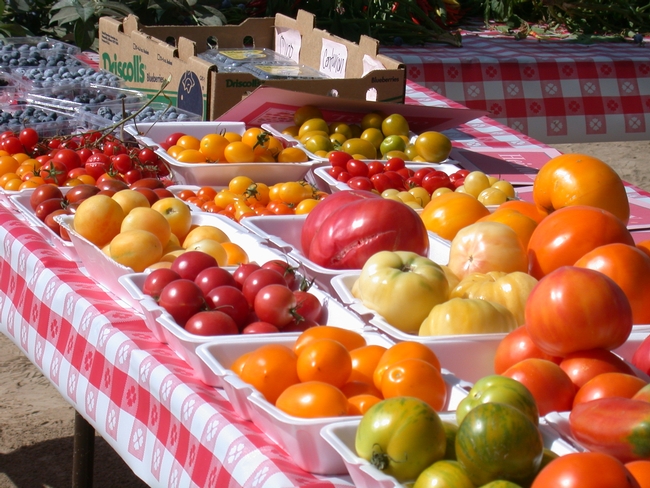Posts Tagged: tomatoes
‘Containergeddon’ at ports cost California farmers $2.1 billion in exports
New research estimates economic losses due to congestion, inefficiencies
Between wildfires, drought, a trade war and the COVID-19 pandemic, the last few years have been hard on California farmers. But recent research by agricultural economists from UC Davis and the University of Connecticut suggests that economic losses to California agriculture from recent supply chain disruptions may have an even greater economic impact.
In an article titled “‘Containergeddon' and California Agriculture,” researchers estimate that there was a 17% decline in the value of containerized agricultural exports between May and September 2021, resulting from recent port congestion. This amounts to around $2.1 billion in lost foreign sales, which exceeds losses from the 2018 U.S.-China trade war.
By the peak of the disruption in September 2021, nearly 80% of all containers leaving California ports were empty – about 43% fewer filled containers leaving California's ports than there were prior to the pandemic. And since 40% of filled shipping containers leaving California's ports are filled with U.S. agricultural products – around a third of which are from California – farmers in the state experienced significant lost export opportunities.
By September 2021, there were around 25,000 fewer containers filled with agricultural products leaving California ports than there were in May 2021. Processed tomatoes, rice, wine and tree nuts saw the sharpest average trade declines.
“We calculated California tree nut producers lost about $520 million,” said Colin Carter, UC Davis Distinguished Professor of agricultural and resource economics. “This was followed by wine with a loss of more than $250 million and rice with about $120 million lost.”
During the pandemic, an increase in household savings led to increases in consumer spending, with many of these additional goods being imported from Asia. California ports were overwhelmed by the added shipping containers coming in from Asia. At times, bottlenecks at Southern California ports left more than 80 vessels waiting off the coast to unload. Docks and warehouses ran out of space and the turnaround time for shipping containers nearly doubled.
Increased U.S. demand for imported goods from Asia also led to increased demand for empty shipping containers in Asia. Prior to the pandemic, freight rates for shipping containers from Shanghai to Los Angeles were already higher than the return trip from Los Angeles, but this gap widened significantly after COVID-19. By September 2021, the fee to ship a 40-foot container from Shanghai to Los Angeles had increased sixfold to $12,000 – while the return trip from Los Angeles was only $1,400.
The high prices for containers from Asia, coupled with shipping delays from the high volume of imported goods entering California ports, made it more profitable for shippers to return containers to Asia empty, rather than waiting at the ports to have them loaded with U.S. exports for the return trip.
“If port inefficiencies persist, the ramifications for California agriculture will extend beyond the immediate loss of foreign sales, as importers begin to view California as an unreliable supplier of agricultural products,” Carter said.
To learn more about the supply chain disruptions at California ports, and their effect on California agriculture, read the full article by Colin Carter (Distinguished Professor in the Department of Agricultural and Resource Economics at UC Davis), Sandro Steinbach, and Xiting Zhuang (assistant professor and Ph.D. student, respectively, both in the Department of Agricultural and Resource Economics at the University of Connecticut): “‘Containergeddon' and California Agriculture,” ARE Update 25(2): 1–4. UC Giannini Foundation of Agricultural Economics, online at https://giannini.ucop.edu/filer/file/1640021835/20297/.
ARE Update is a bimonthly magazine published by the Giannini Foundation of Agricultural Economics to educate policymakers and agribusiness professionals about new research or analysis of important topics in agricultural and resource economics. Articles are written by Giannini Foundation members, including University of California faculty and Cooperative Extension specialists in agricultural and resource economics, and university graduate students. Learn more about the Giannini Foundation and its publications at https://giannini.ucop.edu/.
Too many tomatoes?
If you also found a silver lining to staying/working at home this summer by planting and tending to your garden, did your wish for a bumper crop of tomatoes come true? What happens if your tomato plants are prolific producers?
Preserve those tomatoes!
The easiest way to preserve tomatoes is to freeze them. You don't need to blanch them, you don't need to peel them. Just rinse, dry, core, and put them on a small tray or plate in the freezer. Once frozen solid, move them to a freezer bag, removing as much air from the bag as possible before closing. Pull the bag out of the freezer when you're ready to use the tomatoes. To peel, let them thaw just a little and then run each tomato under warm water to slip off the skins. It's that easy. (They won't have the texture of a fresh tomato, but they'll be perfect to make a fresh sauce for dinner.)
Don't throw away those skins! Or soft tomatoes. If you have a dehydrator, lay tomato skins on the tray, sprinkle with your favorite spice mix (garlic salt works well), and dry until crispy to make a tomato skin chip. Some heirloom tomato skins are bursting with flavor. Or instead of making chips, toss tomato skins and soft tomatoes into a freezer bag until you fill the bag. Thaw and puree the bag's contents and dry the mixture on your dehydrator tray as a crisp leather. Grind up the leather to make a tomato powder to use for camping soup mixes and dehydrated salsa mix. Sprinkle tomato powder on scrambled eggs for tomato flavor without the extra moisture or add to meatloaf, burgers or soups to enhance flavor. Get creative!
If you're a canner, there are lots of options. Many people don't think of tomatoes as a basis for jam or jelly, but with the right spices and some sugar, the flavor profile changes significantly. I served Spiced Tomato Jam in a blind taste test with third-graders a few years ago and they guessed it was apple pie and pumpkin pie because of the nutmeg, cinnamon and allspice. It's delicious!
A family favorite is Tomato Apple Chutney. This savory spread is a collection of tomatoes, apples, onions, raisins, garlic, cucumber, red bell peppers, a little sugar and spices. I like to mix it with mayonnaise for a sandwich spread. The first time I made it my husband and I ate sandwiches for lunch and dinner three days in a row. It is one of the first red tomato products I can each summer.
Another family favorite is Roasted Eggplant and Pepper Puttanesca Sauce. The combination of roasted plum tomatoes, eggplant, onions and red peppers with capers, olives, spices, balsamic vinegar and wine make a chunky pasta sauce that smells fabulous when you open the jar. I usually make 3-4 batches and enjoy them all year.
My pantry staple is plain crushed tomatoes. I add spices when I make a meal, cooking them down, adding tomato paste (remember the tomato powder?) and dried veggies. Each jar of crushed tomatoes can become part of a unique meal. The main thing to remember is to add acid to each jar before filling it to ensure there's enough acidity to make the tomatoes a high acid food and safe to can in a steam canner or boiling water canner. I normally use bottled lemon juice, but this year I'm trying a few jars with cider vinegar; rumor has it that after being stored for several months the vinegar flavor mellows and enhances the flavor. I'll label the jars to identify the acid used.
I learned a great tip at one of our public classes a couple of years ago. Often when canning tomatoes, there's watery liquid at the bottom of the cook pot. Don't throw out the tomato water! You can jar and process it with the rest of your crushed tomatoes. Use the tomato water to cook couscous, quinoa, rice or as the liquid in a soup.
This is the first year I've actually put my garden in on time and shouldn't have plants loaded with green tomatoes right before the first freeze. If I do, I'll be thrilled because I'll make Green Tomato Salsa Verde – it's delicious! (It ranks up there with Tomatillo Salsa; I've already made three double batches and plan to make more.) Green tomatoes are more acidic than ripened tomatoes and you can use them in place of red tomatoes in any canning recipe, following standard acidification methods.
I just picked a cherry tomato off the potted plant on my back patio that is purposely within easy snacking distance from my kitchen. If I get too many to eat within a couple of days I'll cut them in half and dehydrate them. The result is as good as candy.
So many tomato possibilities! If you want more ideas, contact the UC Master Food Preserver online help line at Ask a Master Food Preserver.
Visit our website at http://mfp.ucanr.edu/to watch a variety of preservation videos from Cooperative Extension offices around the country, explore recipes, and find out more about the UC Master Food Preserver Program.
UC Agricultural Issues Center releases cost estimates for growing processing tomatoes
A new study on the costs and returns of producing processing tomatoes in Fresno County and the central San Joaquin Valley has been released by the UC ANR Agricultural Issues Center. Growers contemplating crops to grow may use the estimates to help decide whether to plant processing tomatoes.
The report estimates costs and returns and provides an overview of common production practices related to irrigation, fertility and pest management of processing tomatoes. In this report, some specifics are assigned and calculations are based on a hypothetical well-managed farming operation, which is described in detail.
The new study, “Sample Costs to Produce Processing Tomatoes in the San Joaquin Valley South, Fresno County – 2018,” can be downloaded for free from the UC Davis Department of Agricultural and Resource Economics website at http://coststudies.ucdavis.edu. Sample cost of production studies for many other commodities are also available.
For additional information or an explanation of the calculations used in the study, contact Jeremy Murdock at the Agricultural Issues Center at (530) 752-4651 or jmmurdock@ucdavis.edu, or Tom Turini, UCCE farm advisor for Fresno County, at taturini@ucanr.edu.
UC updates costs and returns of growing processing tomatoes
The analysis is based upon a hypothetical well-managed farming operation using practices common to the region. The costs, materials and practices shown in this study will not apply to all farms. Growers, UC Cooperative Extension farm advisors and other agricultural associates provided input and reviewed the methods and findings of the study.
The hypothetical 3,500-acre farm, focuses on production costs for growing transplanted processing tomatoes under subsurface drip irrigation on 60-inch beds in San Joaquin County and the lower Sacramento Valley.
The authors describe the assumptions used to identify current costs for production, material inputs, cash and non-cash overhead. Ranging analysis tables show profits over a range of prices and yields. Other tables show the monthly cash costs, the costs and returns per acre, hourly equipment costs, and the whole farm annual equipment, investment and business overhead costs.
The new study, “Sample Costs to Produce Processing Tomatoes, Sub-Surface Drip Irrigated (SDI) in the Sacramento Valley & Northern Delta – 2017,” and sample cost-of-production studies for many other commodities are available for free. To download the cost studies, visit the UC Davis Department of Agricultural and Resource Economics website at http://coststudies.ucdavis.edu.
For additional information or an explanation of the calculations used in the studies, contact the Agricultural Issues Center's Donald Stewart at (530) 752-4651 or destewart@ucdavis.edu, Brenna Aegerter, UC Cooperative Extension farm advisor for San Joaquin County at bjaegerter@ucanr.edu, or Gene Miyao, UC Cooperative Extension farm advisor for Yolo, Solano and Sacramento counties at emmiyao@ucanr.edu.
The cost and returns program is funded by the UC Agricultural Issues Center, which is part of UC Division of Agriculture and Natural Resources, and the UC Davis Department of Agricultural and Resource Economics.
Grafting tomato transplants could improve taste and yield
Two UC Cooperative Extension advisors are conducting field research to determine whether grafting tasty tomato plants onto high-performing root stock will increase yield and disease resistance while improving tomato flavor, reported Ezra David Romero on Valley Public Radio.
Romero spoke to Scott Stoddard, the UCCE vegetable crops advisor for Madera and Merced counties, and Margaret Lloyd, the UCCE small farms advisor for Yolo, Solano and Sacramento counties.
Stoddard has planted 3,500 grafted tomato seedlings on a farm north of Madera.
“Now we got them in the field and so approximately 83 days from now, if all goes according to plan, we will be harvesting out here and we will see if we can see some yield differences,” Stoddard said.
Lloyd grafted heirloom tomato varieties onto disease-resistant roots on a quarter acre at UC Davis.
“We're kind of working at this level of finding non-chemical management tools that will help overcome these challenges so they [farmers] can continue to grow these nice heirloom varieties,” says Lloyd.
Both scientists will collect data from their trails to see whether it makes sense for growers to implement the practice on their farms. Romero reported that both agreed consumers could, in time, have a tastier, larger assortment of tomatoes to purchase at farmers markets and stores.


